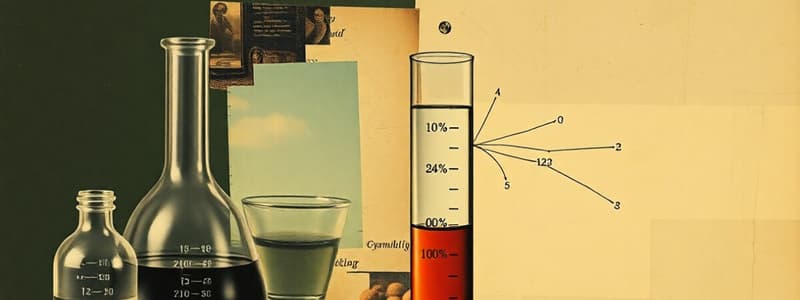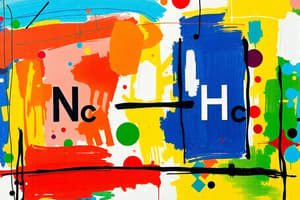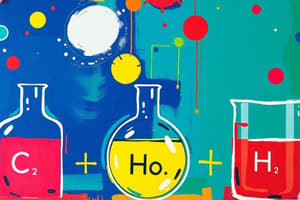Podcast
Questions and Answers
In stoichiometry, what information is essential for converting between the amounts of two different substances in a chemical reaction?
In stoichiometry, what information is essential for converting between the amounts of two different substances in a chemical reaction?
- The physical state (solid, liquid, or gas) of each substance.
- The mole ratio derived from the balanced chemical equation. (correct)
- The density of each substance.
- The color of each substance.
What is the primary difference between a mole-to-mole conversion and a gram-to-gram conversion in stoichiometry?
What is the primary difference between a mole-to-mole conversion and a gram-to-gram conversion in stoichiometry?
- Gram-to-gram conversions are direct and only require one step, while mole-to-mole conversions require multiple steps.
- Mole-to-mole conversions only require the mole ratio, while gram-to-gram conversions also require molar masses. (correct)
- Mole-to-mole conversions involve experimental measurements, while gram-to-gram conversions are purely theoretical.
- Mole-to-mole conversions require the use of molar masses, while gram-to-gram conversions do not.
Sulfur dioxide ($SO_2$) reacts with oxygen gas ($O_2$) to form sulfur trioxide ($SO_3$) according to the equation $2SO_2 + O_2
ightarrow 2SO_3$. If you have 6.8 moles of $SO_2$, how many moles of $SO_3$ can be produced?
Sulfur dioxide ($SO_2$) reacts with oxygen gas ($O_2$) to form sulfur trioxide ($SO_3$) according to the equation $2SO_2 + O_2 ightarrow 2SO_3$. If you have 6.8 moles of $SO_2$, how many moles of $SO_3$ can be produced?
- 3.4 moles
- 2.27 moles
- 6.8 moles (correct)
- 13.6 moles
Propane ($C_3H_8$) reacts with oxygen gas ($O_2$) as follows: $C_3H_8 + 5O_2
ightarrow 3CO_2 + 4H_2O$. If 5.6 moles of $C_3H_8$ react completely, how many moles of $H_2O$ are formed?
Propane ($C_3H_8$) reacts with oxygen gas ($O_2$) as follows: $C_3H_8 + 5O_2 ightarrow 3CO_2 + 4H_2O$. If 5.6 moles of $C_3H_8$ react completely, how many moles of $H_2O$ are formed?
Given the reaction $C_3H_8 + 5O_2
ightarrow 3CO_2 + 4H_2O$, if 11.6 moles of $CO_2$ are produced, how many moles of $O_2$ were required?
Given the reaction $C_3H_8 + 5O_2 ightarrow 3CO_2 + 4H_2O$, if 11.6 moles of $CO_2$ are produced, how many moles of $O_2$ were required?
Aluminum (Al) reacts with chlorine gas ($Cl_2$) to form aluminum chloride ($AlCl_3$): $2Al + 3Cl_2
ightarrow 2AlCl_3$. If 68 g of Al react with excess chlorine, what mass of $AlCl_3$ is produced?
Aluminum (Al) reacts with chlorine gas ($Cl_2$) to form aluminum chloride ($AlCl_3$): $2Al + 3Cl_2 ightarrow 2AlCl_3$. If 68 g of Al react with excess chlorine, what mass of $AlCl_3$ is produced?
Consider the reaction: $2Al + 3Cl_2
ightarrow 2AlCl_3$. If you want to produce 266.66 g of $AlCl_3$, what mass of Al is required?
Consider the reaction: $2Al + 3Cl_2 ightarrow 2AlCl_3$. If you want to produce 266.66 g of $AlCl_3$, what mass of Al is required?
Given the balanced equation $2SO_2 + O_2
ightarrow 2SO_3$, if 128 g of $SO_2$ completely react, what mass of $O_2$ is required?
Given the balanced equation $2SO_2 + O_2 ightarrow 2SO_3$, if 128 g of $SO_2$ completely react, what mass of $O_2$ is required?
What is the general sequence of steps required to convert grams of reactant A to grams of product B in a chemical reaction?
What is the general sequence of steps required to convert grams of reactant A to grams of product B in a chemical reaction?
In the reaction $C_3H_8 + 5O_2
ightarrow 3CO_2 + 4H_2O$, how many grams of water ($H_2O$) are produced from 88.184 grams of propane ($C_3H_8$)?
In the reaction $C_3H_8 + 5O_2 ightarrow 3CO_2 + 4H_2O$, how many grams of water ($H_2O$) are produced from 88.184 grams of propane ($C_3H_8$)?
Flashcards
Mole-to-Mole Conversion
Mole-to-Mole Conversion
Converts moles of one substance to moles of another using the balanced equation's coefficients.
Mole-to-Gram/Gram-to-Mole Conversion
Mole-to-Gram/Gram-to-Mole Conversion
Converts between moles and grams of different substances involved in a chemical reaction.
Gram-to-Gram Conversion
Gram-to-Gram Conversion
Converts grams of one substance to grams of another using the balanced chemical equation.
Stoichiometry
Stoichiometry
Signup and view all the flashcards
Mole Ratio
Mole Ratio
Signup and view all the flashcards
Moles of $SO_2$ to $SO_3$
Moles of $SO_2$ to $SO_3$
Signup and view all the flashcards
Moles of $C_3H_8$ to Grams of $CO_2$
Moles of $C_3H_8$ to Grams of $CO_2$
Signup and view all the flashcards
Grams of Al to Grams of $AlCl_3$
Grams of Al to Grams of $AlCl_3$
Signup and view all the flashcards
Study Notes
Stoichiometry Introduction
- Stoichiometry involves three main types of conversions for chemical reactions.
- These conversions relate to the amounts of reactants and products in a balanced equation.
Mole-to-Mole Conversion
- This is the simplest type of stoichiometric conversion.
- It involves converting moles of substance A to moles of substance B.
- Identification of the mole ratio is crucial for this conversion.
- The mole ratio is derived from the coefficients in the balanced chemical equation.
Mole-to-Gram and Gram-to-Mole Conversion
- Involves converting moles of substance A to grams of substance B.
- The reverse is also possible: converting grams of substance A to moles of substance B.
- This type of conversion generally requires two steps.
Gram-to-Gram Conversion
- This is the most complex of the basic stoichiometric conversions.
- Grams of substance A are converted to grams of substance B.
- This type of conversion usually involves three steps.
Example 1: Sulfur Dioxide and Oxygen Gas
- Sulfur dioxide ($SO_2$) reacts with oxygen gas ($O_2$) to form sulfur trioxide ($SO_3$).
- Balanced chemical equation: $2SO_2 + O_2 \rightarrow 2SO_3$
Example 1A: Moles of Sulfur Dioxide to Moles of Sulfur Trioxide
- Problem: If 3.4 moles of $SO_2$ reacts with excess $O_2$, find moles of $SO_3$ formed.
- Mole ratio between $SO_2$ and $SO_3$ is 2:2 (or 1:1).
- Calculation: 3.4 moles $SO_2$ will produce 3.4 moles of $SO_3$.
Example 1B: Moles of Sulfur Dioxide to Moles of Oxygen Gas
- Problem: How many moles of $O_2$ react completely with 4.7 moles of $SO_2$?
- Mole ratio between $SO_2$ and $O_2$ is 2:1.
- Calculation: 4.7 moles $SO_2 * (1 \text{ mol } O_2 / 2 \text{ mol } SO_2) = 2.35 \text{ moles } O_2$
Example 2: Propane and Oxygen Gas
- Propane ($C_3H_8$) reacts with oxygen gas ($O_2$) to form carbon dioxide ($CO_2$) and water ($H_2O$).
- Balanced chemical equation: $C_3H_8 + 5O_2 \rightarrow 3CO_2 + 4H_2O$
Example 2A: Moles of Propane to Grams of Carbon Dioxide
- Problem: If 2.8 moles of $C_3H_8$ reacts with excess $O_2$, find grams of $CO_2$ formed.
- Steps: Convert moles of $C_3H_8$ to moles of $CO_2$ using the mole ratio, then to grams of $CO_2$ using its molar mass.
- Molar mass of $CO_2$: 44.01 g/mol.
- Mole ratio between $C_3H_8$ and $CO_2$ is 1:3.
- Calculation: $2.8 \text{ mol } C_3H_8 * (3 \text{ mol } CO_2 / 1 \text{ mol } C_3H_8) * (44.01 \text{ g } CO_2 / 1 \text{ mol } CO_2) = 369.68 \text{ g } CO_2 $
Example 2B: Moles of Propane to Grams of Oxygen Gas
- Problem: How many grams of $O_2$ react completely with 3.8 moles of $C_3H_8$?
- Steps: Convert moles of $C_3H_8$ to moles of $O_2$ using the mole ratio, then to grams of $O_2$ using its molar mass.
- Molar mass of $O_2$: 32 g/mol.
- Mole ratio between $C_3H_8$ and $O_2$ is 1:5.
- Calculation: $3.8 \text{ mol } C_3H_8 * (5 \text{ mol } O_2 / 1 \text{ mol } C_3H_8) * (32 \text{ g } O_2 / 1 \text{ mol } O_2) = 608 \text{ g } O_2$
Example 2C: Grams of Propane to Moles of Water
- Problem: If 25 g of $C_3H_8$ reacts with excess oxygen, how many moles of $H_2O$ will form?
- Steps: Convert grams of $C_3H_8$ to moles of $C_3H_8$ using its molar mass, then to moles of $H_2O$ using the mole ratio.
- Molar mass of $C_3H_8$: 44.094 g/mol.
- Mole ratio between $C_3H_8$ and $H_2O$ is 1:4.
- Calculation: $25 \text{ g } C_3H_8 * (1 \text{ mol } C_3H_8 / 44.094 \text{ g } C_3H_8) * (4 \text{ mol } H_2O / 1 \text{ mol } C_3H_8) = 2.27 \text{ mol } H_2O$
Example 2D: Grams of Water to Moles of Carbon Dioxide
- Problem: If 38 g of $H_2O$ are produced, how many moles of $CO_2$ were produced?
- Steps: Convert grams of $H_2O$ to moles of $H_2O$ using its molar mass, then to moles of $CO_2$ using the mole ratio.
- Molar mass of $H_2O$: 18.016 g/mol.
- Mole ratio between $H_2O$ and $CO_2$ is 4:3.
- Calculation: $38 \text{ g } H_2O * (1 \text{ mol } H_2O / 18.016 \text{ g } H_2O) * (3 \text{ mol } CO_2 / 4 \text{ mol } H_2O) = 1.58 \text{ mol } CO_2$
Example 3: Aluminum and Chlorine Gas
- Aluminum (Al) reacts with chlorine gas ($Cl_2$) to form aluminum chloride ($AlCl_3$).
- Balanced chemical equation: $2Al + 3Cl_2 \rightarrow 2AlCl_3$
- Aluminum has a +3 charge, while chloride has a -1 charge.
Example 3A: Grams of Aluminum to Grams of Aluminum Chloride
- Problem: If 35 g of Al reacts with excess chlorine, how many grams of $AlCl_3$ will form?
- Steps: Convert grams of Al to moles of Al using its molar mass, then to moles of $AlCl_3$ using the mole ratio, and finally to grams of $AlCl_3$ using its molar mass.
- Molar mass of Al: 26.98 g/mol.
- Molar mass of $AlCl_3$: 133.33 g/mol.
- Mole ratio between Al and $AlCl_3$ is 2:2 (or 1:1).
- Calculation: $35 \text{ g } Al * (1 \text{ mol } Al / 26.98 \text{ g } Al) * (2 \text{ mol } AlCl_3 / 2 \text{ mol } Al) * (133.33 \text{ g } AlCl_3 / 1 \text{ mol } AlCl_3) = 172.96 \text{ g } AlCl_3$
Example 3B: Grams of Aluminum to Grams of Chlorine Gas
- Problem: How many grams of $Cl_2$ will react completely with 42.8 g of Al?
- Steps: Convert grams of Al to moles of Al using its molar mass, then to moles of $Cl_2$ using the mole ratio, and finally to grams of $Cl_2$ using its molar mass.
- Molar mass of Al: 26.98 g/mol.
- Molar mass of $Cl_2$: 70.9 g/mol.
- Mole ratio between Al and $Cl_2$ is 2:3.
- Calculation: $42.8 \text{ g } Al * (1 \text{ mol } Al / 26.98 \text{ g } Al) * (3 \text{ mol } Cl_2 / 2 \text{ mol } Al) * (70.9 \text{ g } Cl_2 / 1 \text{ mol } Cl_2) = 168.75 \text{ g } Cl_2$
Studying That Suits You
Use AI to generate personalized quizzes and flashcards to suit your learning preferences.




